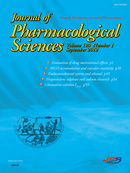Volume 124, Issue 4
Displaying 1-13 of 13 articles from this issue
- |<
- <
- 1
- >
- >|
Full Paper
-
2014Volume 124Issue 4 Pages 409-417
Published: April 20, 2014
Released on J-STAGE: April 17, 2014
Download PDF (858K) -
2014Volume 124Issue 4 Pages 418-426
Published: April 20, 2014
Released on J-STAGE: April 17, 2014
Advance online publication: March 27, 2014Download PDF (882K) -
2014Volume 124Issue 4 Pages 427-432
Published: April 20, 2014
Released on J-STAGE: April 17, 2014
Advance online publication: March 19, 2014Download PDF (691K) -
2014Volume 124Issue 4 Pages 433-444
Published: April 20, 2014
Released on J-STAGE: April 17, 2014
Download PDF (609K) -
2014Volume 124Issue 4 Pages 445-456
Published: April 20, 2014
Released on J-STAGE: April 17, 2014
Advance online publication: March 27, 2014Download PDF (5039K) -
2014Volume 124Issue 4 Pages 457-467
Published: April 20, 2014
Released on J-STAGE: April 17, 2014
Advance online publication: March 19, 2014Download PDF (794K) -
2014Volume 124Issue 4 Pages 468-479
Published: April 20, 2014
Released on J-STAGE: April 17, 2014
Download PDF (1466K) -
2014Volume 124Issue 4 Pages 480-485
Published: April 20, 2014
Released on J-STAGE: April 17, 2014
Advance online publication: March 28, 2014Download PDF (475K) -
2014Volume 124Issue 4 Pages 486-493
Published: April 20, 2014
Released on J-STAGE: April 17, 2014
Download PDF (1291K) -
2014Volume 124Issue 4 Pages 494-501
Published: April 20, 2014
Released on J-STAGE: April 17, 2014
Advance online publication: April 02, 2014Download PDF (613K) -
2014Volume 124Issue 4 Pages 502-510
Published: April 20, 2014
Released on J-STAGE: April 17, 2014
Advance online publication: March 29, 2014Download PDF (827K)
Short Communication
-
2014Volume 124Issue 4 Pages 511-513
Published: April 20, 2014
Released on J-STAGE: April 17, 2014
Advance online publication: March 27, 2014Download PDF (448K) -
2014Volume 124Issue 4 Pages 514-517
Published: April 20, 2014
Released on J-STAGE: April 17, 2014
Advance online publication: March 27, 2014Download PDF (358K)
- |<
- <
- 1
- >
- >|
